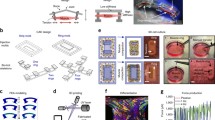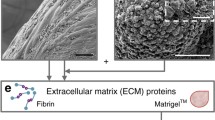Abstract
As microcomponents in engineered systems, biological muscles have unique advantages such as large force transduction, utilization of biochemical fuel, and self-assembly from single cells, over other inorganic actuators for biomedical engineering applications. Successful integration of muscles with inorganic fabricated structures and electronics promises the capability of precisely characterizing muscles' mechanical properties and fabricating self-assembled controllable autonomous structures powered by ubiquitous glucose. However, the use of extracted muscle tissue from animals on these devices is impractical and inefficient, as the tissues must be dissected and incorporated into each device by hand with crude interfaces between the biological tissue and inorganic materials. Integration of muscle with fabricated structures would be optimally achieved through self-assembling muscle cells on MEMS. The construction of self-assembled muscle-powered MEMS structures is complicated by the stringent requirements to spatially direct the cell growth, control the tight connection of these differentiated structures with MEMS structures, and enable the cells and the integrated hybrid freedom to move. Conventional and soft photolithography techniques have been extensively employed to pattern the growth of a variety of cell types and investigate their interaction with substrate in the micrometer level. However, all studies are only suitable for patterning static cells on an immobile surface, so a novel system of spatially patterning the contractible cells must be developed to enable the cells and the integrated hybrid devices to be free to move.
We present a novel system of self-assembling myocytes on MEMS devices. This system has shown its capability of spatially and selectively directed growth and differentiation of myocytes into single muscle bundles, attachment of these functional bundles to MEMS structures, and the controlled partial release of the resultant hybrid devices. Two groups of self-assembled muscle-MEMS devices, force-measuring cantilevers and muscle-powered microrobots have been created. Here the further detailed studies of this system are discussed, especially the concept of the self-assembly and the material interfacial problems in this system.
Similar content being viewed by others
References
A. J. Brady, “Mechanical properties of isolated cardiac myocytes,” Physiol Rev, vol. 71, pp. 413–28, 1991.
M. E. Fauver, D. L. Dunaway, D. H. Lilienfeld, H. G. Craighead, and G.H. Pollack, “Microfabricated cantilevers for measurement of subcellular and molecular force,” IEEE transactions on Biomedical Engineering, vol. 45, pp. 891–898, 1998.
W. Herzog, Skeletal muscle mechanics: John Wiley & Sons, LTD, 2000.
G. Lin, R. E. Palmer, K. S. J. Pister, and K. P. Roos, “Miniature heart cell force transducer system implemented in MEMS technology,” IEEE Transactions on Biomedical Engineering, vol. 48, pp. 996–1006, 2001.
J. Z. Xi, J. Schmidt, and C. Montemagno, “A Novel System for the Self-Assembly of Muscle on Microdevices,” In Preparation, 2003.
T. Okano, N. Yamada, H. Sakai, and Y. Sakurai, “A novel recovery system for cultured cells using plasma-treated polystyrene dishes grafted with poly(N-isopropylacrylamide),” Journal of Biomedical Materials Research, vol. 27, pp. 1243–1251, 1993.
T. Shimizu, M. Yamato, A. Kikuchi, and T. Okano, “Two-dimensional manipulation of cardiac myocytes sheets utilizing temperature-responsive culture dishes augments the pulsatile Amplitude,” Tissue Engineering, vol. 7, pp. 141–151, 2001.
D. McMahon, P. Anderson, R. Nassar, J. B. Bunting, Z. Saba, A. Oakeley, and N. Malouf, “C2C12 cells: biophysical, biochemical, and immunocytochemical properties,” the American Physiological Society, vol. 35, pp. C1795–C1802, 1994.
R. S. Ross, C. Pham, S. Y. Shai, J. I. Goldhaber, C. Fenczik, C. C. Glembotski, M. H. Ginsberg, and J. C. Loftus, “ß1 integrins participate in the hypertrophic response of rat ventricular myocytes,” Circulation Research, vol. 82, pp. 1160–1172, 1998.
A. Sen, P. Dunnmon, S. A. Henderson, R. D. Gerard, and K. R. Chien, “Terminally differentiated neonatal rat myocardial cells proliferate and maintain specific differentiated functions following expression of SV40 large T antigen,” Journal of Biological Chemistry, vol. 263, pp. 19132–19136, 1988.
A. Folch and M. Toner, “Microengeering of Cellular Interactions,” Annu. Rev. Biomed. Eng., vol. 02, pp. 227–56, 2000.
R. S. Kane, S. Takayama, E. Ostuni, D. E. Ingber, and G. M. Whitesides, “Patterning proteins and cells using soft lithography,” Biomaterials, vol. 20, pp. 2363–2376, 1999.
P. Fromherz, “Electrical interfacing of nerve cells and semiconductor chips,” Chemphyschem, vol. 3, pp. 276–284, 2002.
Y. Ito, “Surface micropatterning to regulate cell functions,” Biomaterials, vol. 20, pp. 2333–2342, 1999.
M. Yamato, C. Konno, M. Utsumi, A. Kikuchi, and T. Okano, “Thermally responsive polymer-grafted surfaces facilitate patterned cell seeding and co-culture,” Biomaterials, vol. 23, pp. 561–567, 2002.
M. Yamato, M. Utsumi, A. Kushida, C. Konno, A. Kikuchi, and T. Okano, “Thermo-responsive culture dishes allow the intact harvest of multilayered keratinocyte sheets without dispase by reducing temperature,” Tissue Engineering, vol. 7, pp. 473–480, 2001.
G. Chen, Y. Ito, and Y. Imanishi, “Regulation of growth and adhesion of cultured cells by insulin conjugated with thermoresponsive polymers,” Biotechnology and Bioengineering, vol. 53, pp. 339–344, 1997.
Z. Hu, Y. Chen, C. Wang, Y. Zheng, and Y. Li, “Polymer gels with engineered environmentally responsive surface patterns,” Nature, vol. 393, pp. 149–152, 1998.
Acknowledgments
The authors would like to thank Dr. William Robb MacLellan at UCLA for offering cardiac myocytes. We want also to thank Dr. Jinsoo Yi and Dr. Jordon Patti for their suggestion.
Author information
Authors and Affiliations
Rights and permissions
About this article
Cite this article
Xi, J., Schmidt, J.J. & Montemagno, C.D. Development of Self-assembled Muscle-powered Microdevices. MRS Online Proceedings Library 820, 138–143 (2004). https://doi.org/10.1557/PROC-820-O5.8/W9.8
Published:
Issue Date:
DOI: https://doi.org/10.1557/PROC-820-O5.8/W9.8




